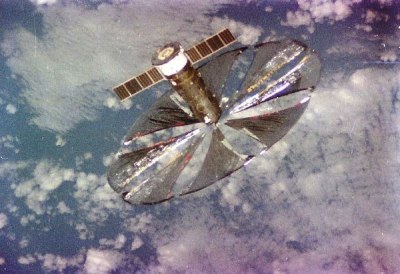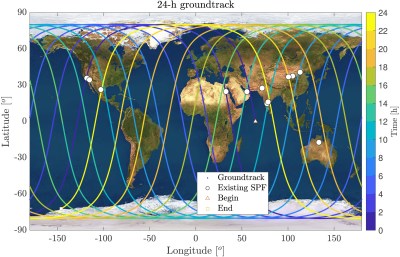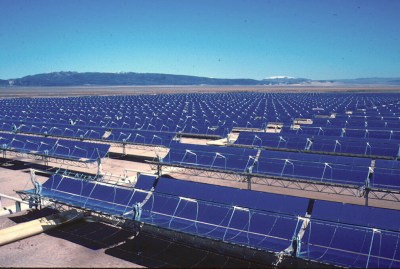Recently, a company by former SpaceX employee Ben Nowack – called Reflect Orbital – announced that it is now ready to put gigantic mirrors in space to reflect sunshine at ground-based solar farms. This is an idea that’s been around for a hundred years already, both for purposes of defeating the night through reflecting sunshine onto the surface, as well as to reject the same sunshine and reduce the surface temperature. The central question here is perhaps what the effect would be of adding or subtracting (or both) of solar irradiation on such a large scale as suggested?
We know the effect of light pollution from e.g. cities and street lighting already, which suggests that light pollution is a strongly negative factor for the survival of many species. Meanwhile a reduction in sunshine is already a part of the seasons of Autumn and Winter. Undeniable is that the Sun’s rays are essential to life on Earth, while the day-night cycle (as well as the seasons) created by the Earth’s rotation form an integral part of everything from sleep- and hibernation cycles, to the reproduction of countless species of plants, insects, mammals and everyone’s favorite feathered theropods.
With these effects and the gigantic financial investments required in mind, is there any point to space-based mirrors?
Night-Be-Gone

Of all proposed space-based reflectors and deflectors, the only one to make it past the theoretical stage into testing is the Soviet-era Znamya (‘banner’) satellite. This was originally a solar sail project by Vladimir Syromyatnikov, who would try to get funding for it by pitching it to the USSR leadership in 1988 as a way to bring sunshine to the northern regions of the USSR with their short, cold days. This would extend daylight hours for outdoor work, and potentially also find uses in metropolitan settings, effectively driving night away and removing the need for street and indoor lighting.
Not too long after this Znamya 2 project began, the USSR collapsed, but like so many parts of the USSR space program, Znamya 2 would coast into the uncertain years of the 1990s under the auspice of newly formed Russian companies. With the USSR’s Mir space station still in orbit, it was the ideal platform from which this satellite could be launched. When in February of 1993 this experiment took place, it was considered a success, with the satellite unfolding its 20-meter mirror and casting a roughly 5 km diameter spot of reflected light over pre-dawn Europe.
Yet as if the atmosphere was making a statement, it was cloudy that day over Europe, and those on the ground did not observe much of this new light in the sky, which was said to be on par with that of the full Moon. Following this experiment, the Znamya 2.5 satellite was prepared, with a larger mirror. Unfortunately, the deployment of this satellite failed, with the mirror getting caught on an antenna of the Progress spacecraft. After failed attempts to free the mirror, the satellite was deorbited and along with Znyamya 2.5 the program went up in ashes.
What would have been the impact if the USSR and its successor state had launched hundreds or even thousands of Znamya satellites into orbit?
Light Pollution

How would a world without night fare? This is not an entirely theoretical question either, as those who live at or near the Earth’s poles are well aware of. Yet it’s not simply a matter of day or night, with the sky brightening during night time around the globe a little bit more each year. At this point over a third of the world’s population cannot see the Milky Way any more at night, which is not just a cosmetic inconvenience, but also has very real implications for human health. Much of this is due to how it affects the circadian rhythm and aspects of it, such as the production of melatonin.
An increasing body of evidence supports the notion that exposure to (artificial) light during night time suppresses the production of melatonin, which can have a range of undesirable effects, including poor sleep and even the development of cancer. A 2018 review study by Leena Tähkämö and colleagues in Chronobiology International finds that even an increase in background lighting levels (even with one’s eyes closed) can affect one’s circadian rhythm. This is also an issue with pregnant women, a 2021 study by Karin Windsperger, MD and colleagues in Birth on the ease of delivery and health of newborns describes. Since melatonin passes through the placenta, a disrupted maternal circadian rhythm will thus also negatively affect the development of the fetus.
The ecological impacts of a decreasing night amidst phenomena like skyglow range from new selective pressures on night-time insects and mammals – e.g. decreased effectiveness of camouflage – to the risk of extinction of entire species, such as with newborn turtles who only know to move away from the darkness (the coast) and towards the lighter area (moon-lit ocean), but end up crawling onto brightly lit roads instead where they all too often find their early demise. The case of the Post Tower in Bonn, Germany, clearly demonstrates how birds can be disoriented by light pollution from buildings and consequently collide with said buildings.
Eternal Day

Most recently, the focus with space mirrors appears to be on addressing the primary issue with photovoltaic solar farms, being their lack of production when night falls. Much like how Soviet planners imagined loggers and farmers productively working in eternal daylight, so too would today’s solar farms produce power around the clock. Although Reflect Orbital hasn’t released many – if any – details on what their proposed satellite constellation would look like, a (EU Horizon 2020 grant-supported) 2024 study by Onur Çelik and Colin R. McInnes, as published in Acta Astronautica, titled A constellation design for orbiting solar reflectors to enhance terrestrial solar energy details a few deployment approaches.
This paper suggests initially 20 space mirrors in sun-synchronous orbits at the dawn/dusk terminator, in a fairly typical Walker constellation. What’s not typical is that instead of the satellites trying to blend into the darkness of space, they’d instead do the equivalent of a satellite flare cranked up to well over 9,000. Rather than a glint that may upset an astronomer trying to capture the night sky, instead it’d blast a fairly narrow beam of sunlight at the Earth’s atmosphere. Since the Earth’s atmosphere is not an optically transparent medium, but instead refracts and diffuses light (hence Rayleigh scattering and blue skies), this would create a skyglow from Hell if you’re an astronomer.
Just that one aspect ought to be enough to disabuse anyone of the notion of trying space mirrors for chasing the night away. When it is not ruining astronomy even further, the other aspects of human health effects, ecological destruction and whichever exciting consequences we’d stand to discover as a result, the sheer cost and complexity of putting these massive mirrors into space and controlling them should give anyone pause.
Aiming space mirrors at the Earth and hitting a few PV solar farms is a feat where, if you pay attention, the marketing and studies never seem to mention clouds, fog or other weather events that make sunshine not reach the Earth’s surface as well. Meanwhile we got low-carbon power sources that do not require space mirrors or ecological destruction to produce 24/7.
Reclaiming The Night

If it’s solar that you want, but the lack of 24/7 production has you down, then concentrated solar power (CSP) has been around for a while. Although the tower-based form of CSP, like Ivanpah in the Mojave desert, have a bad rap if only for their bird-killing powers, parabolic-trough CSP circumvents many of the issues, including less complicated solar tracking, due to the parabolic part. CSP generally comes with its own thermal storage system, which gives CSP built-in energy storage for hours and thus makes it a dispatchable source of power.
Although storage-less PV solar used to get a higher return, dispatchable power sources are more highly valued these days, which is why CSP is making a comeback. These solar plants will happily produce power during the night from their stored heat, although they do best in areas with a lot of sunshine. Much like the non-solar options of nuclear and hydro dams, these do not share the main flaw that makes PV solar such a pain to manage, while being dispatchable, low-carbon and do not ruin the night and astronomy more than we have already managed so far. This appears to be the course set by the European Union at the recent Nuclear Energy Summit as well, with the EU and others increasingly opting for such low-impact sources.
Considering the importance of maintaining the day-night cycle on Earth based on the evidence we have available, it is hoped that we never see space mirrors become a reality, and instead we can focus on technologies that will really make life better on Earth. Or, if we really want to do PV solar and satellites, we can burn a big stack of money on space-based solar while leaving precious night time intact.

















“Considering the importance of maintaining the day-night cycle on Earth based on the evidence we have available, it is hoped that we never see space mirrors become a reality”
I appreciate the dive into the biological/scientific/sociological effects, but the smarter bet might’ve been to focus on how amazingly bad the cost/benefit is and the ridiculous engineering challenges.
I think even the authors understand the insanity – one of the papers refers to another study and hilariously says “the size of the mirror satellites [(__120 square kilometers!!__)] gives one pause”. Really?!
And then they go to propose a mirror that’s still scale-wise bigger than the International Space Station and we’ll only need to launch 28,800 of them and somehow the orbital dynamics of maintaining all of those will just be hunky-dory, but it’s OK because all of this will only cost $28B and it’s a more “down to Earth” (ha) project than the Curiosity rover.
so, so bad
This kind of thing is usually more a venture into 70s futurism nostalgia rather than serious business venture. You know, kind of like the dumb belief that we can terraform Mars, a planet with a third the mass of ours and absolutely no magnetic field to prevent its atmosphere from blowing away.
Reminder that the starship rocket has very little realistic concern paid towards long term-human habitability in solar orbit, such as radiation shielding. Nobody is going to Mars on that.
“rather than serious business venture.”
Yes, but they still get grant and VC money for it!
“Reminder that the starship rocket”
Starship, sadly, has two components – the upper stage, and the booster which was originally Falcon Super Heavy. For some inane reason SpaceX is obsessed with connecting the two into some weird launch system thing, and so people are fascinated by the weird sci-fi stainless steel shiny upper stage.
But *by far* the key to cheaper deep-space access is the booster, not the upper stage (the booster has *11 times* the number of engines, f’crying out loud). If the booster becomes reliable and reusable (a *very big* if at this point) the upper stage doesn’t matter, deep space access becomes cheap. Which is why the key with IFT-3 wasn’t “ooh starship took pretty pictures” but “hey look at least the booster didn’t explode this time.”
TL;DR version – the design of the upper stage of Starship means exactly zippo for getting to other planets, it’s all about the booster.
“a mirror that’s still scale-wise bigger than the International Space Station and we’ll only need to launch 28,800 of them”
Look at the bright (ha) side: it will work wonderfully to catch all that debris in orbit.
Nah, it’d create *more* of it. And then, because the other reflectors are in the same orbit, the torn-off pieces of each of them would be most likely to hit the others. Now add in the fact that each of these guys is effectively super-light (~1200 kg, because they *have* to be to be cheap to launch) and you’ve got a nice recipe for Kessler.
I would like to congratulate these guys for recommending a mega-constellation smack-dab in the worst space-junk region, too. A+ design, there.
Yeah they aren’t gonna do any of this ever. But there will will be unthinkable horrors and damages necessary to feed 10 billion and counting, the number always rising. Already have been.
We also have to worry about a bond villain turning it into a space laser.
I feel like Futurama already showed us the dangers if a giant mirror array in space. One little asteroid and we’d be like ants under a magnifying glass.
So many ants, such a small magnifying glass…
The Earth does not raise its average temperature enough with just human industry activity, let’s do better with huge mirrors, maybe also get some more pure water by melting the poles…
It looks like SpaceX’s boss madness is contagious !
I hear he gives all his friends Nehru jackets and white cats.
Yup. They need to put the mirrors up there, pointed away from Earth during the daytime.
It’s hard to see this making economic sense in any context, but using it to boost terrestrial solar power seems especially dubious. If you can orbit a solar-farm-sized array of mirrors, why not cut out the extremely complicated middleman, put the solar farm in orbit, and use a microwave beam to collect the power? (Also very challenging, but could harvest more power, more reliably, more of the time)
If you could have year-round summer in a city like London or Stockholm, people might actually value that enough to make financial sense, and big cities don’t have remotely normal ecological conditions anyway. But I feel like it’d have to be geosynchronous (hence even huger mirrors). No one would want a disconcerting bright shooting star that shows up at dawn and dusk and has to be rebuilt from scratch every two years. But a second sun fixed halfway up the sky might be pretty nice in winter.
It’s just another techno-boondoggle, like the big-league version of solar roadways. It’s “futuristic and cool” and sounds just plausible enough for bureaucrats and VCs.
Hey. Geeks love “futuristic and cool” as well.
A solar farm in space, beaming down power in microwaves? Oh! An orbital death ray! Yay! Now we can file it under the military budget!
Or just build solar farms on opposite sides of the planet. Spend the rest of the money on batteries.
Heck, I’m pretty sure building and maintaining a worldwide electrical grid is more practical than a megaconstellation of giant mirrors in low earth orbit.
Perhaps it will end up being necessary to install these mirrors on the surface of the planet to reflect light into space and try to alleviate global warming in this way.
“Live Free Or Die” by John Ringo
Thank you so much! I like a good read and this book has it all. Excitement, suspense with a mix of humour.
If say a soccer field sized reflector reflects 95% down and the atmosphere eats up more it could only make daylight intensity down here on a football pitch not even in the stands. Lower intensities over a larger area could do something but there is no magic intensity amplification. We are getting ready to do a big light experiment Monday in the middle US, even with expected clouds it will be interesting lots of data to gather.
Am I missing something here? Surely if you want to provide perpetual daylight over continental USSR, its simply a matter of deploying a perfect solar reflector the size of the USSR… Easy!
I’m frankly surprised nobody thought of it sooner. Wait a minute, do I see a slight flaw in this plan.
On a serious note. If you want twice as much solar power, there is a much cheaper and simpler option. Install twice as many solar panels.
>> terraform Mars, a planet with a third the mass of ours and absolutely no
>> magnetic field to prevent its atmosphere from blowing away.
Ummmm it’s gravity, not magnetism, that keeps the atmosphere here.
Mars doesn’t have much gravity, either, though, so terraforming mars would still be a challenge.
csw
“Ummmm it’s gravity, not magnetism, that keeps the atmosphere here.”
It’s the combination of the two. You lose atmosphere just naturally due to thermal (Jeans) escape, but that’s subdominant for inner planets. The dominant mechanisms involve interactions with the solar wind.
However, generally the people who talk about Mars needing a magnetic field to keep its atmosphere have it overblown a bit: if you dump an atmosphere on Mars right now, it’ll hold it for a very long time, and realistically the reason why Mars’s atmosphere is *so* thin right now isn’t because it didn’t have a magnetic field, it’s because it lost a *lot* of atmosphere early on due to a combination of being small (volcanic outgassing, etc.) and unprotected from impacts.
It’s tough because if you look in literature you’ll find a lot of people talking about Mars losing ~1 bar of atmosphere due to solar wind interactions over the past ~billions of years, and so you immediately think “oh, that’s why Mars lost its atmosphere and Earth didn’t.” Except Earth’s atmosphere’s basically been obliterated over the same time, too – it just was able to build it back because it can retain a lot of outgassed materials.
So it’s a little simplistic to say “Mars would have a thick atmosphere like Earth today if it had a magnetic field.” It probably still wouldn’t.
+70% of that extra sunlight goes directly into waste heat, so you are literally contributing more to global warming than you are to electricity production. And if there are clouds the warming impact is proportionately higher.
Get over the whole “solar power is the panacea” delusion, man made and not natural fusion is the future of energy production.
Oh, this is so wrong on every level. This will take global warming and crank it up to immediate kill for everybody.
the hubris of humans… where to start with how dumb of an idea this is…